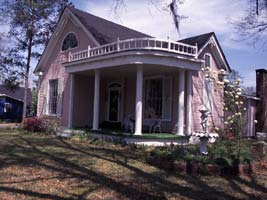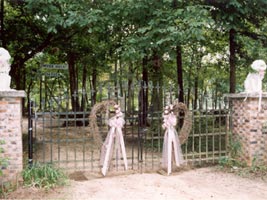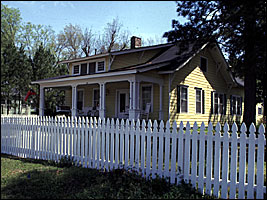The Stonewall Mill Village Historic District is a historic, planned industrial community. Begun in 1872, the district consists of an industrial complex and its associated village of 70 buildings. The industrial complex included in the district boundaries is comprised of four buildings—two textile mills, an office building, and a powerhouse. This complex borders the south side of Erwin Road (State Hwy. 513), which is the main route through town and forms the southern boundary of the district. The core of the historic mill village is laid out in a gridlike pattern on the north side of Erwin Road.
The small commercial area lies on the north side of Erwin Road, opposite Mill No. 2. Slightly more than half the houses are located in the core area of the village to the north/northeast of the mills. Of these residences, those along School Street and Wainwright Avenue were historically the homes of supervisors. The other housing was for the mill hands. Also included in the district are a former commissary, a former health clinic, and a one-story commercial building. [Significant buildings no longer standing include T.L. Wainwright’s mansion, the opera house, the school, the railroad depot, the Baptist church, and the Methodist church.] The industrial complex manufactured textiles, but the village was incorporated in 1965 and is no longer owned by the mill company.
Sense of Character
Many residences in the mill village have been lost over time. One former resident estimates there were about 100 mill houses in Stonewall in 1921, and many more were constructed or moved in after that year. By 1946, there were 212 mill houses. [Despite these losses, there are a few vacant lots in the historic district.] The mill village maintains its character and its sense of time and place as the buildings retain their spatial relationship to each other. They still display their original proportions, scale, massing, and design. Though specific architectural details may be missing or altered, primary design features such as front porches, roof configurations, and window and door openings, for the most part, have been preserved.
The mill village was established in 1872, the same year a syndicate of ten cotton factors from Mobile purchased the Stonewall Manufacturing Company from its original owners. The earliest Sanborn Map for Stonewall, dated 1885, indicated there were “scattered dw’gs” from the north of Erwin Road. Many sources report that the interiors of homes for the mill hands were not finished. The walls were not plastered, and no ceilings were installed. The framing for the structures was left exposed. The interiors of mill houses were described as “devoid of paint, paper or plaster, very poorly furnished, and somewhat untidy….” While it was unusual for a mill town to have a sewage system of running water, the offices, the commissary, and the mill executives’ residences had indoor plumbing by 1912; however, the workers had no indoor water and used outhouses until the 1920’s.
Mills Bring Prosperity
The mills prospered, and Stonewall grew significantly in the period between the World Wars. In 1912, the village had a population of 1,000, and the mills employed 500 workers. By 1921, there were approximately 100 mill houses in Stonewall. Every house was encircled by a picket fence and had an outhouse in its yard. There was no indoor plumbing, but outdoor pumps scattered around the village provided water. Electricity was added to the housing in 1927. By 1938, Stonewall’s population was 2,048. The WPA Guide described the village as being “dominated by a cotton textile mill that rises giant-like above rows of low mill houses. The mill…is one of the largest in the state.” Eight hundred workers (excluding management) were employed in the mills in 1946.
End of an Era
The mill village, which was begun in 1872, existed until 1965 when Stonewall was incorporated and became a self-governing unit. The mill company began to sell its village property in March 1966. Most of the mill houses sold for $400 to $600 each. At that time, some of the mill housing was moved from the village to other sites. The first brick, ranch-style house was built in Stonewall on Estelle Avenue in October 1966, and others soon followed.
For additional information, please visit http://www.stonewallcottonmill.com.
Romona’s Mill House
 Circa 1872 • Highway 513 • Stonewall, MS.
Circa 1872 • Highway 513 • Stonewall, MS.
One of the oldest homes built by the Stonewall Manufacturing Company. Rented and later purchased from Erwin Mills in 1966 by Wayne and Ramona Schrimpshire. With the look of old distinction, the simple mill house has evolved into a Colonial three-columned portico and gable roof in the Greek Revival style.
River Walk

County Road 320 • Stonewall, MS.
Visit lovely “Four Porches” cabin on the banks of the Chickasawhay River and tour the landscaped grounds decorated according to the season of the year. For cabin tours, please call (601) 659-4486.
Mill No. 1
Circa 1882, 1889, & 1902.
Mill No. 1 of the Stonewall Cotton Mills functioned as a textile mill. The Stonewall Manufacturing Company was founded in 1867 and incorporated under that name in 1870; therefore, the first mill must have been constructed between 1867 and 1870.
Mill No. 2
Circa 1895 & 1897.
Construction on Mill No. 2 began in October 1895. The mill cost $250,000 to construct and was described in a 1905 edition of The Clarke County Times as a “model and modern cotton mill, with all of the latest and most approved improvements know to cotton mill experts.”
Stonewall Cotton Mills Office Building
Circa Between 1895 and 1900.
This mill was constructed at about the same time as Mill No. 2.
Millstone
 Circa 1898.
Circa 1898.
An imposing Victorian-era bungalow, Millstone was built by the Stonewall Manufacturing Company for department head executives and their families. Millstone was occupied for several years by Jim Halley and family. Halley is most remembered as editor of The Stonewall Item. Millstone holds many original architectural features. In keeping with the period of the house, it is furnished with heirloom pieces and antiques. Listed as part of Stonewall Mill Village Historical District, placed on the National Register in 1994, it is the home of the Doug Thomas family.
Stonewall Cemetery
Stonewall/Clarkco Road
Lovely old cemetery located in the heart of Stonewall. Some graves date back to 1890.
